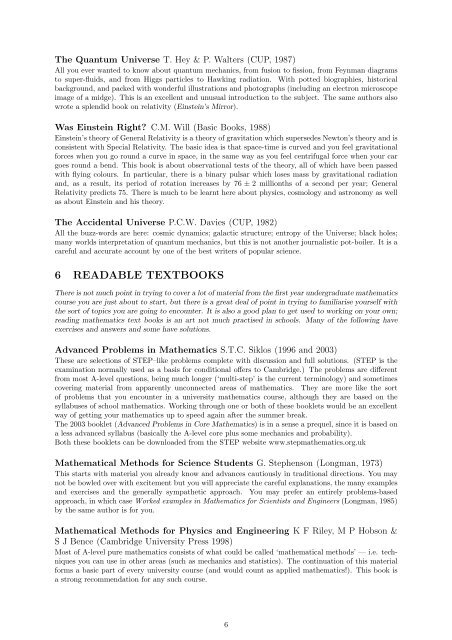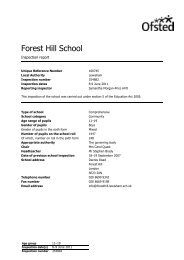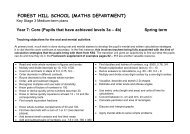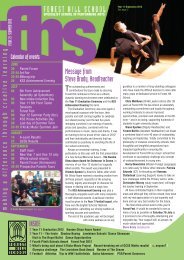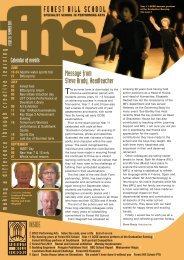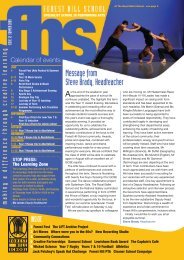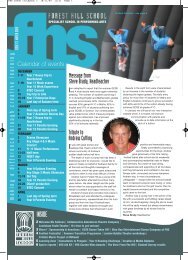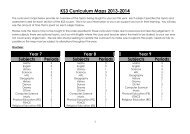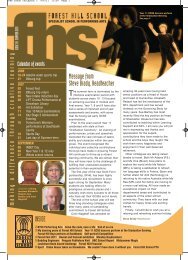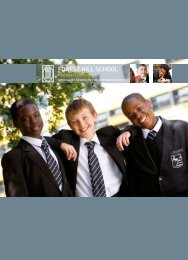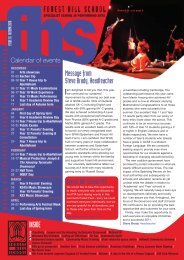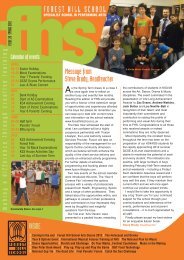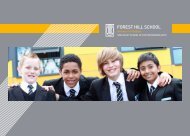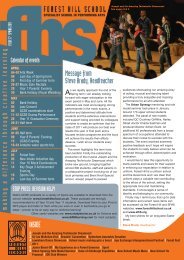University of Cambridge's Mathematical Reading List
University of Cambridge's Mathematical Reading List
University of Cambridge's Mathematical Reading List
- No tags were found...
You also want an ePaper? Increase the reach of your titles
YUMPU automatically turns print PDFs into web optimized ePapers that Google loves.
The Quantum Universe T. Hey & P. Walters (CUP, 1987)All you ever wanted to know about quantum mechanics, from fusion to fission, from Feynman diagramsto super-fluids, and from Higgs particles to Hawking radiation. With potted biographies, historicalbackground, and packed with wonderful illustrations and photographs (including an electron microscopeimage <strong>of</strong> a midge). This is an excellent and unusual introduction to the subject. The same authors alsowrote a splendid book on relativity (Einstein’s Mirror).Was Einstein Right? C.M. Will (Basic Books, 1988)Einstein’s theory <strong>of</strong> General Relativity is a theory <strong>of</strong> gravitation which supersedes Newton’s theory and isconsistent with Special Relativity. The basic idea is that space-time is curved and you feel gravitationalforces when you go round a curve in space, in the same way as you feel centrifugal force when your cargoes round a bend. This book is about observational tests <strong>of</strong> the theory, all <strong>of</strong> which have been passedwith flying colours. In particular, there is a binary pulsar which loses mass by gravitational radiationand, as a result, its period <strong>of</strong> rotation increases by 76 ± 2 millionths <strong>of</strong> a second per year; GeneralRelativity predicts 75. There is much to be learnt here about physics, cosmology and astronomy as wellas about Einstein and his theory.The Accidental Universe P.C.W. Davies (CUP, 1982)All the buzz-words are here: cosmic dynamics; galactic structure; entropy <strong>of</strong> the Universe; black holes;many worlds interpretation <strong>of</strong> quantum mechanics, but this is not another journalistic pot-boiler. It is acareful and accurate account by one <strong>of</strong> the best writers <strong>of</strong> popular science.6 READABLE TEXTBOOKSThere is not much point in trying to cover a lot <strong>of</strong> material from the first year undergraduate mathematicscourse you are just about to start, but there is a great deal <strong>of</strong> point in trying to familiarise yourself withthe sort <strong>of</strong> topics you are going to encounter. It is also a good plan to get used to working on your own;reading mathematics text books is an art not much practised in schools. Many <strong>of</strong> the following haveexercises and answers and some have solutions.Advanced Problems in Mathematics S.T.C. Siklos (1996 and 2003)These are selections <strong>of</strong> STEP–like problems complete with discussion and full solutions. (STEP is theexamination normally used as a basis for conditional <strong>of</strong>fers to Cambridge.) The problems are differentfrom most A-level questions, being much longer (‘multi-step’ is the current terminology) and sometimescovering material from apparently unconnected areas <strong>of</strong> mathematics. They are more like the sort<strong>of</strong> problems that you encounter in a university mathematics course, although they are based on thesyllabuses <strong>of</strong> school mathematics. Working through one or both <strong>of</strong> these booklets would be an excellentway <strong>of</strong> getting your mathematics up to speed again after the summer break.The 2003 booklet (Advanced Problems in Core Mathematics) is in a sense a prequel, since it is based ona less advanced syllabus (basically the A-level core plus some mechanics and probability).Both these booklets can be downloaded from the STEP website www.stepmathematics.org.uk<strong>Mathematical</strong> Methods for Science Students G. Stephenson (Longman, 1973)This starts with material you already know and advances cautiously in traditional directions. You maynot be bowled over with excitement but you will appreciate the careful explanations, the many examplesand exercises and the generally sympathetic approach. You may prefer an entirely problems-basedapproach, in which case Worked examples in Mathematics for Scientists and Engineers (Longman, 1985)by the same author is for you.<strong>Mathematical</strong> Methods for Physics and Engineering K F Riley, M P Hobson &S J Bence (Cambridge <strong>University</strong> Press 1998)Most <strong>of</strong> A-level pure mathematics consists <strong>of</strong> what could be called ‘mathematical methods’ — i.e. techniquesyou can use in other areas (such as mechanics and statistics). The continuation <strong>of</strong> this materialforms a basic part <strong>of</strong> every university course (and would count as applied mathematics!). This book isa strong recommendation for any such course.6


